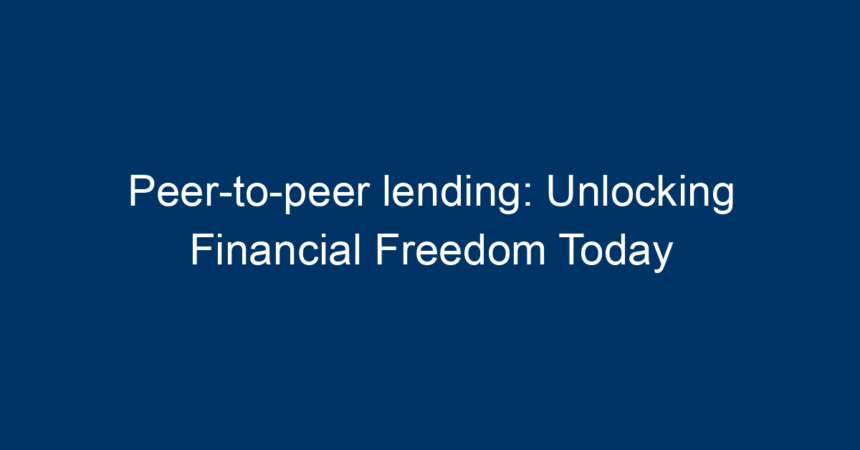In today’s digital age, financial landscapes are constantly evolving, and with these changes come innovative opportunities for individuals to take control of their financial destinies. One such innovative opportunity is peer-to-peer lending (P2P lending). This method of borrowing and lending money cuts out traditional financial institutions, allowing individuals to lend and borrow directly from each other. In this comprehensive guide, we’ll explore the concept of peer-to-peer lending, its benefits, and pitfalls, and how it can unlock financial freedom for both borrowers and investors.
What is Peer-to-Peer Lending?
Peer-to-peer lending is a method through which individuals lend money directly to other individuals, typically through online platforms. These platforms match borrowers with lenders, creating a marketplace that facilitates loans without the need for a bank or credit union. By leveraging technology, P2P lending has become a popular alternative to traditional banking loans, offering competitive interest rates and greater accessibility for borrowers.
The P2P Lending Process
-
Application: Borrowers complete an online application, providing necessary financial information and the amount they wish to borrow.
-
Risk Assessment: The platform evaluates the borrower’s creditworthiness, often using alternative data alongside traditional credit scores. This assessment helps determine the interest rate.
-
Listing and Funding: Once approved, the loan is listed on the platform. Lenders can review borrower profiles and choose to fund all or part of the loan.
- Repayment: Borrowers make monthly repayments, which lenders receive as returns on their investments.
Benefits of Peer-to-Peer Lending
1. Attractive Interest Rates
Borrowers often find that interest rates in P2P lending are significantly lower than traditional bank rates. This lower cost can be attributed to the lack of intermediaries and operational costs that banks incur. For lenders, these platforms offer the potential for higher returns compared to traditional savings or investment accounts.
2. Accessibility
One of the main advantages of peer-to-peer lending is the accessibility it offers. Borrowers who may struggle to qualify for traditional loans due to credit history or income can often find a more welcoming environment within P2P platforms. Lenders also benefit from a broader range of investment options, as they can choose from a variety of loans that match their risk tolerance.
3. Diversification
For investors, peer-to-peer lending allows for easy diversification. Rather than putting a significant amount of money into one loan, lenders can spread their investment across multiple borrowers, reducing risk. This strategy increases the likelihood of consistent returns over time.
4. Transparency
P2P lending platforms provide detailed information about each borrower, including their credit scores, loan purpose, and approval status. This transparency empowers lenders to make informed decisions about their investments.
5. Social Impact
Investing in peer-to-peer loans can be viewed as a way to support individual borrowers and small businesses, which contributes to economic growth. Lenders often take pride in helping others achieve their financial goals, creating a sense of community within the P2P lending space.
Risks of Peer-to-Peer Lending
1. Default Risk
One of the primary risks associated with peer-to-peer lending is the potential for borrower default. If a borrower fails to repay their loan, lenders may lose part or all of their investment. It’s crucial for lenders to assess borrower profiles and diversify their investments to mitigate this risk.
2. Platform Risk
The credibility of the P2P lending platform itself is essential. If a platform encounters financial difficulties or goes out of business, lenders may find it challenging to recover their investments. Therefore, it’s essential to choose reputable platforms with a history of reliability and user satisfaction.
3. Limited Regulation
While P2P lending is subject to some regulatory oversight, it lacks the extensive regulations that govern traditional financial institutions. This lack of oversight may expose lenders to risks that they wouldn’t encounter with conventional banking.
4. Liquidity Concerns
Investments in peer-to-peer loans are often less liquid than traditional investments. Once capital is tied up in a loan, it may not be easily accessible until the borrower repays the loan, which can present challenges for lenders needing immediate cash.
Is Peer-to-Peer Lending Right for You?
For Borrowers
If you’re considering P2P lending as a borrowing option, evaluate your financial situation carefully. Borrowers with higher credit scores will find competitive rates, but those with lower scores may still benefit from P2P lending due to its more lenient approval criteria. Additionally, consider how much you need and your ability to repay before taking the plunge.
For Investors
For potential investors, peer-to-peer lending offers an exciting opportunity to generate passive income. However, like any investment, it requires due diligence. Consider the following steps before investing:
-
Research Platforms: Look for platforms with solid reputations, transparent operations, and positive reviews.
-
Assess Risk Tolerance: Understand your risk appetite and invest accordingly. Avoid putting all your funds into one loan.
-
Diversify Investments: Spread your investments across various borrowers and loan types to mitigate risks.
- Monitor Performance: Regularly review your portfolio’s performance to make adjustments as necessary.
Conclusion: Taking Control of Your Financial Future
Peer-to-peer lending stands as a revolutionary alternative in the world of finance, offering unique opportunities to both borrowers seeking funds and investors looking for reliable returns. By understanding the mechanisms, benefits, and risks associated with P2P lending, individuals can make informed decisions that could unlock financial freedom and growth.
As you consider your next steps, whether you are looking to borrow or invest, remember that knowledge is power. Evaluate your options, choose reputable platforms, and take control of your financial journey. Peer-to-peer lending could very well be the vehicle to achieving the financial freedom you’ve always envisioned.
Actionable Insights
-
For Borrowers: Explore various P2P lending platforms, compare interest rates, and read borrower reviews before applying.
- For Lenders: Start small, diversify your investments, and continually reassess your portfolio to enhance returns while managing risks effectively.
Armed with this knowledge, you’re now ready to navigate the realm of peer-to-peer lending. Embrace the opportunities it offers and unlock the financial freedom that awaits!




